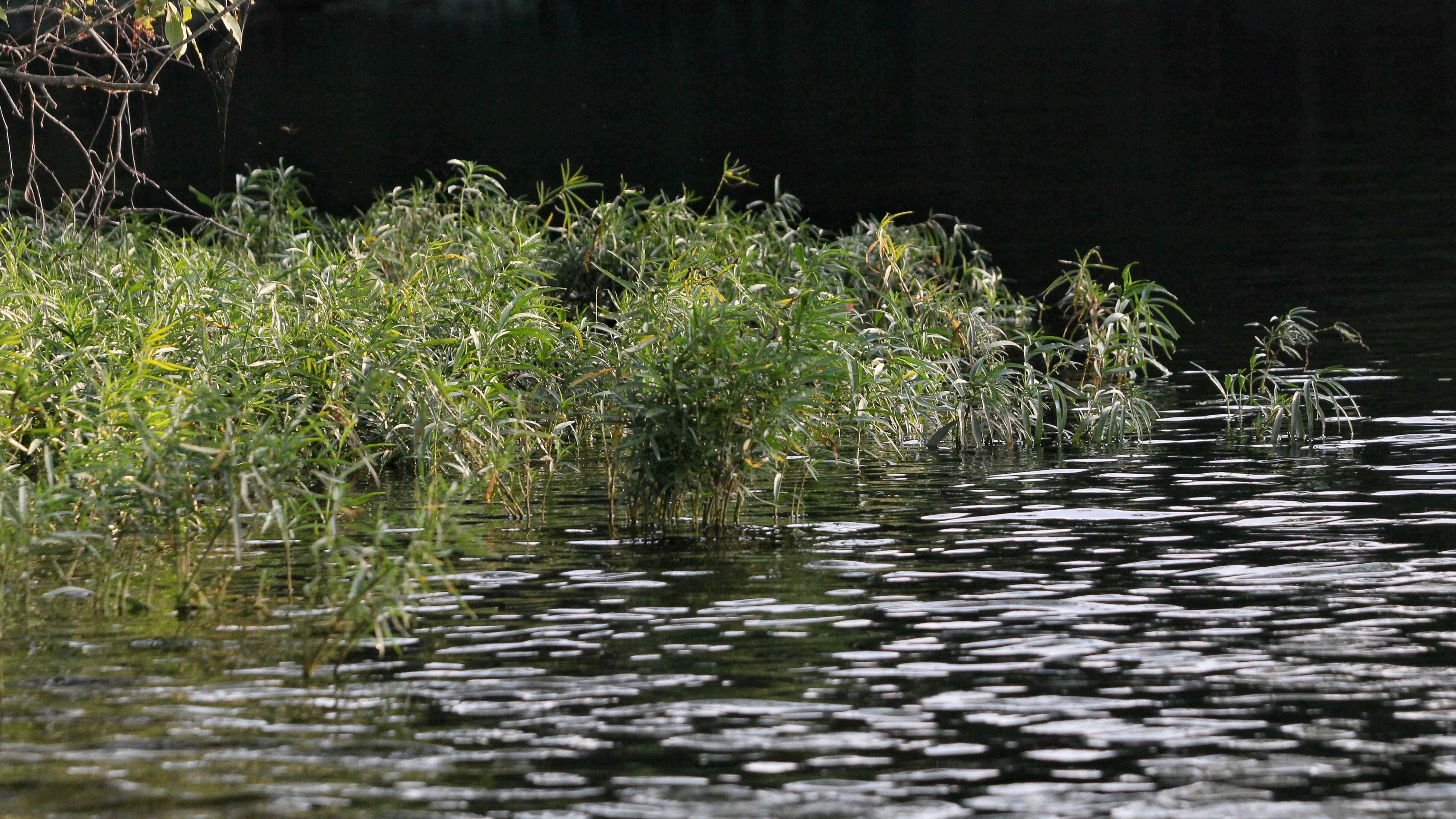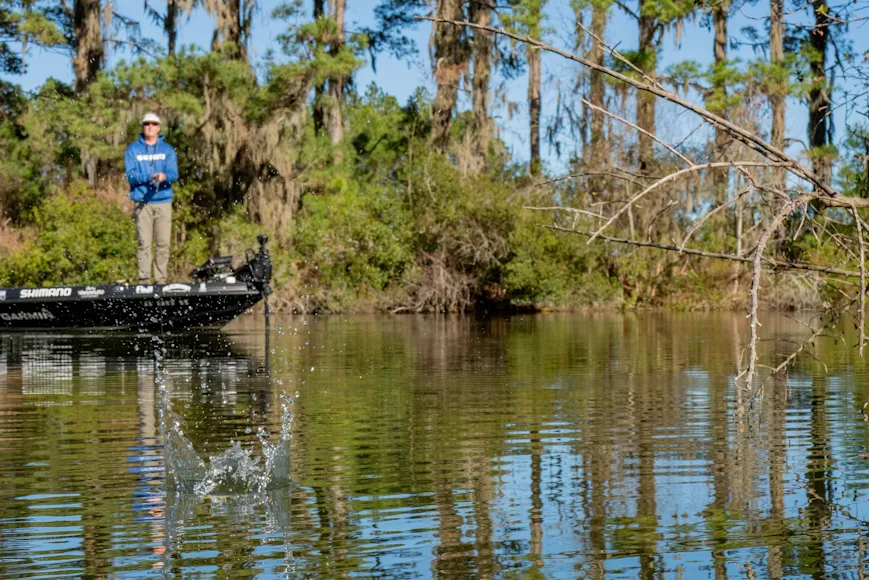Though a swim jig is a great tool for targeting all black bass species, it is typically associated most with fishing for largemouth around shallow vegetation. Yes, you can catch spotted, smallmouth, and largemouth bass in open water with these baits. You can fish them around and along isolated cover like docks, stumps, trees, seawalls, and riprap banks, too. Swim jigs can even mimic shad, bluegill, perch, goby, and a variety of other baitfish from a foot deep out to 20 feet. But targeting shallow vegetation with these baits is the most effective way to trigger a bite from a big bass. Here's how to do it.

Why Swim a Jig Around Vegetation
It's no secret that bass love vegetation and there are few baits better at pulling them out of grass than a swim jig. Frogs and toads can work really well in these situations, but there are times when bass will simply boil on these baits, unwilling to commit to eating them all the way. This is when a swim jig shines because bass that will only roll on a topwater will typically inhale a jig swam right under the surface.
Spinnerbaits are great subsurface lures for fishing around and through sparse vegetation. But as the grass, reeds, and lily pads thicken, the blades on a spinnerbait get bogged down and become useless. A swim jig can slip and slide right through thick vegetation and even be fished over the top of it when the grass and weeds are completely choked out.
When to Swim a Jig Around Vegetation
Though most bass push shallow in the spring to spawn, many make their way back out to deeper water to ride out the summer, fall, and winter. But even after springtime, there are usually some bass in shallow using the cover to escape the heat and ambush prey. That means there’s always a time to fish a swim jig. You just need to look for vegetation.
In late winter and early spring, the vegetation is often submerged. This is when you need to use your graphs to find submerged hydrilla, coontail, or milfoil. Once summer sets in, the vegetation will reach the surface and become easily visible to the naked eye. As the summer fades into fall, most vegetation chokes out, and you can often only fish the edges or scattered holes in the mats.

How to Swim a Jig Around Vegetation
If you’re fishing around submerged vegetation, you want to let your bait get down in the grass. You should still be able to see it with your eyes, just like when fishing it on the surface, but you’ll also be able to feel the jig ticking through the grass. Keep the bait moving at a continuous clip, and then pop the rod tip a little when you feel the bait collide with the cover. This will make the bait shoot up in the water column a little, and then it will fall as you catch back up and start your retrieve again. This little burst and pause is often what will trigger a strike.
Once the cover begins to top out, you’ll need to speed your retrieve up so that the jig doesn’t bog down in the cover. It may even be necessary to go with a lighter jig, opting for a 3/8 ounce instead of a 1/2 ounce to fish through the submerged vegetation. Keep your rod tip pretty high as you bring your swim jig over and through the grass, letting it fall back slightly back under the surface when you reach a void in the cover. Keep your rod tip moving constantly, giving it a steady shake to impart a scurrying action onto the bait.

Gear for Swimming a Jig
For this style of fishing, you’ll want fairly heavy gear. A 7-foot, 3-inch medium heavy rod with a fast action is a great selection, and the Lew’s Custom Lite is a superb option. Pair the rod with a fairly fast baitcaster—something like the Lew’s HyperMag in 7.5:1 gear ratio—will allow you to keep the bait moving quickly and catch up to fish to set the hook when they bite. Spooling this setup with a quality braided line is a must. I like 40 Sufix 832 braided line.
As for the bait, there is no better swim jig on the market than the Dirty Jigs No-Jack Swim Jig. I’ve used this swim jig for a decade now. The color choices are solid, and the head design is ideal for working through and over cover. But it is the hook that has made me believe in this bait. The oversized “No-Jack” Gamakatsu hook will not bend out. I’ve handled dozens of big bass out of dense cover and flipped them into the boat with this thing. No other swim jig is needed for this style of fishing.
When selecting the weight of your jig, remember to focus primarily on the depth you’re fishing. It’s really hard to fish a 1/2-ounce jig over dense cover without it bogging down. It’s equally difficult fish a 3/8-ounce jig slow enough to work it through submerged cover well. Choose your color based on the type of forage you’re fishing around. Use darker colors for mimicking bluegill and bream and use lighter colors to imitate shad, herring, crappie, and other, more paled-out prey.
Your trailer selection can make all the difference too. I almost always use one of two soft plastics as a swim jig trailer: a swimbait or a craw. If you want to fish deeper, use a swimbait as a trailer since this style of bait offers less resistance. If you want to keep your bait higher in the water column, go with a craw. The craws on a bait like a NetBait Paca Craw or Strike King Rage Craw act like the wings on a plane, providing lift to the bait.
Stay Shallow With Swim Jigs All Year
There’s a lot to consider when swimming a jig: rod size, speed of the reel, color of the jig, style of the trailer, and cadence of the retrieve all matte. Still, this is an easy technique to fish once you get all the pieces in place—and it catches big fish.
Keep the bait moving along and the rod tip bouncing. If and when you see a swirl on your bait—drop the rod tip just a bit and give the fish one second to make sure it’s got it, then lay into it with all you’ve got.


